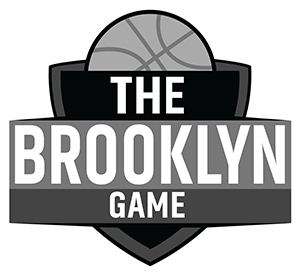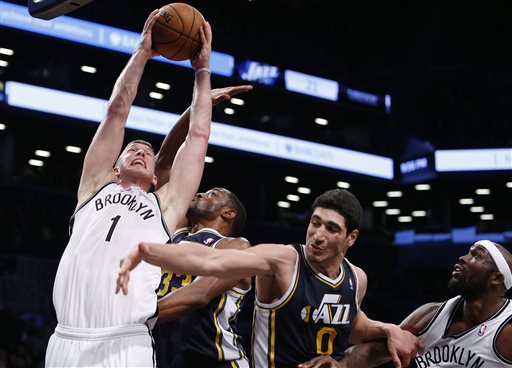
If it wasn’t the best four-minute stretch of Mason Plumlee’s young career, it was certainly the biggest.
In a matter of possessions, Plumlee dunked past LeBron James, blocked a shot high in the air that probably should’ve been a goaltend, rose up for the game-clinching finish to put the team up for good, and most notably, blocked a James dunk attempt that sent the four-time MVP into a rage in the tunnel and sealed the win for Brooklyn, ensuring that the Nets were the first team in the Heat’s “Big 3″ era to sweep the Heat in a four-game season series.
So with the 24-year-old rookie enjoying a bit of shine today, it’s time to ask the bigger question: is Mason Plumlee the top rookie in this class?
[gravityform id=”110″ name=”PLUMS” title=”false” description=”false”]
It’s a wild question. I’ll admit that. Plumlee was the 22nd overall pick in the draft. He’s played less than 20 minutes per game. His per-game pedigree is paltry: just 6.9 points and 4.2 rebounds per game. There’s no realistic chance that he’ll win rookie of the year, because voters often skew towards players with high point totals and minutes played, regardless of efficiency in those minutes. That’s why Michael Carter-Williams, who’s averaging more points (16.7), rebounds (6.1), and assists (6.3) per game than Plumlee is the clear choice, despite Carter-Williams’s poor shooting numbers (clocking in at under 40 percent) and numbers-piling on a bottom-feeding team.
P.S. here’s Plumlee dunking all over Carter-Williams’s 76ers.
But despite his low per-game numbers, some context needs to be applied here. Plumlee leads all rookies in player efficiency rating (18.1) and true shooting percentage (65.7 percent). Here’s a chart comparing Plumlee’s PER to other top rookies, including Carter-Williams:
There are two knocks against Plumlee: first, that he doesn’t play enough playing time to qualify, and second, that he’s an incredibly limited offensive player.
Firstly, it’s true that Plumlee hasn’t played as many minutes as other rookies. Unlike Carter-Williams and Victor Oladipo, Plumlee hasn’t been the top option on his team: he started the year at the end of the bench, and through a series of injuries and impressive plays, worked his way up the ladder into starting all 19 games of Kevin Garnett’s back spasm absence and 22 games overall. But in his starts, his production doesn’t suffer, and even despite playing about half of the minutes Carter-Williams has played, Plumlee still has five times as many win shares (4.0) than Carter-Williams (0.8) by Basketball-Reference’s metric, and only one fewer estimated win added according to ESPN.
Now, let’s deal with the latter. Plumlee dunks. He dunks a lot. He can’t do anything else, but he sure can dunk a lot. In a weird way, he reminds me of a 19-year-old Derrick Favors, who couldn’t hit a shot out of the paint if you gave him a tennis ball and a garbage can, but could run, jump, and dunk, and was effective if you limited him to only just those things. Plumlee is limited to only what he can do, and he does the living hell out of it.
That’s not to say he has no skills. Plumlee has developed as a roll man in the pick-and-roll, looking more comfortable as the season passes setting screens and finding his beeline to the basket. He’s now shooting 63 percent from the field in pick-and-roll situations, drawing fouls on over 20 percent of his logged possessions.
Plumlee’s emergence in the pick-and-roll is twofold: he’s playing off the strength of his teammates and getting more comfortable finishing around the rim. Defensively, teams around the league often bring their bigs “up” on the pick-and-roll, deterring the guard with the ball away from the middle of the floor with two players. The help defense behind the two is supposed to “bump” the rolling big man, but Plumlee’s quick enough to slip the screen quickly and get a good look at the basket.
It’s not just quickness, either: Plumlee also has the strength and in-air agility to drop in shots on and around defenders. Not unlike his dunk on LeBron James last night:
You see all the elements of a successful, basic pick-and-roll play here: Plumlee sets a screen for Deron Williams, Williams gets pushed out of the middle of the floor by Norris Cole and Plumlee’s defender Chris Bosh, and Plumlee gets in the lane quickly enough to sneak a dunk around James.
As for defense? Don’t let just his block on LeBron cloud you to the rest of what he can bring. He’s averaging 1.7 blocks and 1.4 steals per 36 minutes, with everything from chase-down blocks to anticipating passes to, well, you saw what happened to LeBron James.
You could argue that the lack of playing time, and the ability to play as a secondary option around All-Star talent has helped buoy his abilities. But he’s also fit in as the center in Kevin Garnett’s absence, which is no easy task: though he didn’t come close to Garnett’s otherworldly 94.9 defensive rating in his place, his ability to finish at the rim meant the Nets were a more dangerous offensive team, and the two had nearly identical net ratings.
Plumlee won’t win the Rookie of the Year Award. He doesn’t have the gaudy numbers associated with winning the award, he’s not the first (or second, or third, or even fourth) option on offense, and he’s not putting up haphazard numbers on a lottery-bound team. The Nets are pushing the hashtag #Plums4AllRookie, partly because he deserves the credit as a member of the All-Rookie team, but also implicitly because they know there’s no chance he’ll win the bigger award.
But Plumlee is unique both in talent and circumstance: he’s a standout rookie making waves on a team with a real chance to make it out of the first round of the playoffs, something no other rookie can claim. He’s doing it, like fellow role player Shaun Livingston, by understanding how he fits in.



















